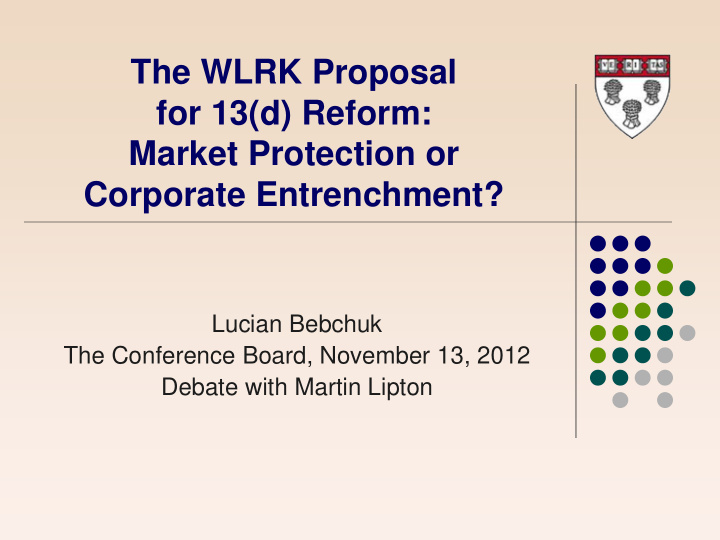



The WLRK Proposal for 13(d) Reform: Market Protection or Corporate Entrenchment? Lucian Bebchuk The Conference Board, November 13, 2012 Debate with Martin Lipton
Talk builds on: Bebchuk and Jackson (2012), The Law and Economics of Blockholder Disclosure. Bebchuk, Brav, Jackson, and Jiang (2012), An Empirical Study of Pre-Disclosure Stock Accumulations. 2
The policy question Tightening 13(d) requirements is not a “technical” change required for effective implementation of the Williams Act. The drafters of the Act explicitly considered prohibiting any pre- disclosure accumulations beyond 5% or using a 7-day period – but then deliberately chose a 10-day limit instead. Senator Williams stated that the Williams Act’s final design took “extreme care to avoid tipping the scales” in either direction. I am open to considering striking a different balance now — but only after a careful policy analysis of benefits and costs and of the best design. 3
The entrenchment context The policy question should be examined in the larger context of the optimal balance of power between incumbents and outside blockholders. US rules insulate incumbent directors from shareholders more than any other advanced economy. Due to the poison pill, US incumbents get unparalleled protection from unsolicited offers they disfavor => Makes monitoring and engagement by significant outside blockholders especially important. 4
The benefits of active outside blockholders WLRK generally looks unfavorably on active outside blockholders. (See, e.g., Lipton, August 2012 WLRK memorandum, Dealing with Activist Hedge Funds) However, financial economists widely recognize that monitoring and engagement by outside blockholders confer significant benefits on all shareholders, reducing slack and enhancing value. 5
The benefits of active outside blockholders (cont.) The view that outside blockholders’ activities benefit other shareholders and the marketplace is supported by a significant body of empirical work: Agrawal and Nasser (2011) Bebchuk, Grinstein and Peyer (2010) Bertrand and Mullainathan (2001) Brav, Jiang, Partnoy and Thomas (2008)) Brickley, Lease and Smith (1988) Klein and Zur (2009) 6
The entrenchment costs of the WLRK proposal The proposal would discourage activism and engagement by outside blockholders: By reducing returns, lowering incentive to purchase a large stake and engage in activities that benefits shareholders in general. Furthermore, and importantly, by facilitating incumbents’ ability to cap the ownership of blockholders they disfavor by adopting a poison pill at a low threshold of 10% or 15%. 7
Changes in market practices? The petition claims that changes in trading patterns and technologies led to increase in pre-disclosure accumulations and thereby require “modernization” of 13(d). However, although information about pre-disclosure accumulations is publicly available from 13(d) filings, the petition fails to provide any systematic examination of how these accumulations have changed over time. The petition refers repeatedly to five anecdotes over the last five years. 8
Changes in market practices? (cont.) Our empirical paper (Bebchuk, Brav, Jackson and Jiang) studies this issue using a dataset of all 13(d) filings by activist hedge funds during 1994-2007. We find no evidence that the size of pre-disclosure accumulations has increased during this period. For the 1980s, Holderness and Sheehan (1985) document many pre-disclosure accumulations over the 5% threshold. Thus, the “modernization” argument made by WLRK is unwarranted. Whatever imperfections the current rule has are ones with which we have lived for a long time. 9
Changes in legal rules The WLRK proposal ignores a clear change taking place since the passage of the Williams Act: Developments in state-law rules have tilted the playing field in favor of incumbents and against outside blockholders. US incumbents are now permitted to adopt low-threshold poison pills that cap the stakes of blockholders they disfavor at a low level. Among the 637 public companies in the SharkRepellent dataset with pills now in place: 80% have pills with a trigger of 15% or less, and 21% have pills with a trigger of 10% or less. 10
Changes in rules around the world Some countries have notice periods shorter than 10 days (though longer than the 1-day period advocated by the WLRK petition…) Considering the rules governing the balance of power between outside blockholders and incumbents as a whole, US rules put blockholders at a far greater disadvantage than they face in any of these other jurisdictions. If anything, a comparative analysis should lead public officials to be concerned that the US rules are overall too tough — not too lax – toward outside blockholders. 11
How low-threshold poison pills hurt market participants The petition claims to seek to protect market participants’ interest in selling at good prices to blockholders seeking a significant stake. Should be even more concerned about poison pills with low thresholds that completely prevent market participants from selling to blockholders seeking 10%+ or 15%+ . No other advanced economy allows incumbents to cap outside blockholders’ ownerships at such low levels. The Williams Act’s designers clearly contemplated markets in which blockholders are not prevented from buying large non-controlling shares. Thus, the SEC should be concerned about the costs that low-threshold pills impose on market participants — and should be wary of taking any actions that would facilitate the use of such pills. 12
The WLRK petition: Market protection or corporate entrenchment? I end with a question to Marty: Are you willing to have any tighter arrangement for blockholder disclosures adopted by the SEC apply only to companies that adopt charter provisions committing them not to adopt pills below the 30% level? If the WLRK petition is driven solely by concerns for market participants, Marty can be expected to accept such a limitation. If the WLRK petition is at least partly focused on protecting incumbents seeking insulation from blockholders, then Marty can be expected not to accept such a limitation. 13
Recommend
More recommend